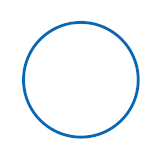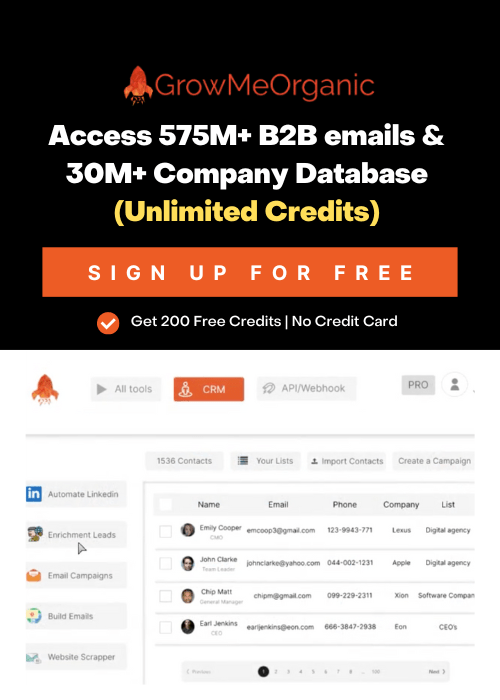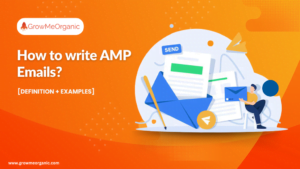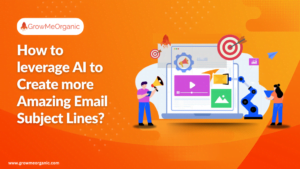Email marketing will always be an effective marketing channel for all businesses.
- Truelist suggests that 50% of B2C customers will visit your website from sent emails.
- Campaign Monitor explains that there is a 65% chance that a customer will visit your website from sent emails.
- Litmus explains that a good email marketing campaign can generate $36 for every $1 spent (36 times email conversion).
So, why is your cold email campaign not working? What is making your email conversion rate take a dip?
Big or small companies must identify the potential pillars of email marketing. To do so, you must learn what email conversion rate is. It assists you in finding the right things you need using a cold email tool online.
Email Conversion Rate: What does it mean?
Email conversion rate measures the percentage of emails opened or interacted with compared to the number of emails sent. It explains to you how many recipients completed a desired action (purchasing, signing up for a webinar, downloading a resource).
To explain it in simple terms, you must know three kinds of email metrics.
- Open rate: An email sent is opened by a recipient. The recipient may or may not engage in any further action with the email content. A good open list percentage is 30 to 40%, as per Bloomreach.
- Click-to-open rate: The click-to-open rate measures the percentage of recipients who take action after opening your cold emails. A healthy click-to-open rate is 15% (Bloomreach).
- Bounce rate: A bounce rate is the percentage of undelivered emails compared to the volume of emails sent. A healthy bounce rate is 5%.
A high conversion rate means your email campaign received a good response from your target audience regarding actions. Conversely, a low conversion rate can indicate issues with your content, targeting, or call to action.
If you understand the components of an email campaign, you can find out what works and what doesn’t. This way, you can improve future campaigns by timing them correctly, setting the right frequency of cold emails, and crafting a compelling call to action (CTA) section.
What Does a Good Email Conversion Rate Look Like? (100 words)
An email conversion rate depends on the following:
- Email list hygiene (verified email lists)
- Govern email campaign frequencies
- Subscriber segmentation (segmenting recipients as per user’s funnel stages)
- Crafting gated or bonus content
- Crafting welcome email in proper sequence
- Easy option to unsubscribe
An average email conversion rate also depends on the type of email sent. Here is what Instapage found.

Credit: Instapage
This statistic shows how email type governs the conversion rate. In terms of industry, Bloomreach suggests how the average conversion rate varies.

Credit: Bloomreach
The success of your cold email outreach program depends on the business type, ideal customer profile (ICP), location, industry, email content, and offer.
Karl Pearson said, “That which is measured improves.”
These numbers vary from email type to industry. However, you can always get better results by making good by crafting compelling cold emails. You can craft an ideal cold outreach strategy by following email conversion metrics. Let us learn how to calculate an email conversion rate.
Calculate Email Conversion Rate Easily
Here is how you can calculate an email conversion rate.
Email Conversion Rate = (Number of emails opened or acted upon/Number of cold emails delivered) X 100
Consider an example. If you have sent 1000 emails and 990 of them were delivered,
Your Email Bounce Rate = [(1000 – 990)/1000] X 100 = 1%
495 recipients opened your emails but did not do anything.
So, your Email Open Rate = (495/990) X 100 = 50%
99 recipients opened your emails and acted upon them.
So, your Email Conversion Rate = (99/990) X 100 = 10%
These calculations reveal how efficiently a cold email outreach campaign has worked.
Why is Calculating Email Conversion Rate Essential?
Understanding the email conversion rate is crucial for crafting email bodies to create good campaigns. Calculating the conversion rate identifies gaps in a cold email outreach and boosts your ROI. Check out these pointers that make calculating email conversion rates essential.
Relevance of email content
An email conversion rate lets you assess the degree of relevance of your cold email content. A high conversion rate means your cold email has addressed recipients’ needs and sparked interest.
They have taken action and engaged in making a buying decision. Higher relevance of email content also results in a low unsubscription rate. Delivering targeted and personalized content boosts conversion rates.
Degree of persuasion
An email conversion rate also signifies how persuasive your email body was. A high conversion rate determined persuasive marketing elements (language and imagery) that made recipients take action.
It also shows how your cold email successfully sent the recipients a clear and concise message. You can easily identify the persuasive elements from a successful cold email campaign that convinced the audience well.
ROI assessment
Email conversion rates assist in determining the ROI of your email campaigns. Higher conversion rates are directly proportional to higher ROI. So, track conversion rates to see which campaigns have driven revenue generation better.
This data will assist in crafting more compelling email campaigns in the future. You can allocate resources to craft better email content, images, and other visual elements.
Trend identification in a lead-base
Monitoring email conversion rates helps you identify trends in a lead base. Identify which email campaigns have been performed and how they have been performed. You will get a clear idea of customer behavior and preferences.
This in-depth insight allows you to tailor future cold email campaigns to align with a target audience’s interest. Adjust your future strategies to improve engagement and predict future needs. So, identify the trends and ensure your emails are relevant to an audience.
Email campaign quality
An email conversion rate is the key indicator of an email campaign’s quality. A high conversion rate shows high email quality and signifies how impactful the campaign was on a target audience. Clear messages, responsive design, and strong CTAs determine the quality of an email campaign.
Common Email Marketing Challenges to Solve
Email marketing faces many challenges that bring down the conversion rate considerably. Let us take a quick look.
Collection and Retention of Subscribers
Collecting and retaining subscribers are the biggest challenges an email marketing campaign faces. The initial persuasion of convincing a lead to sign up with a cold email is the toughest. Amidst digital noise, convincing a lead to visit your website is challenging. Your email campaign must explain the benefits of signing up upfront.
Spam Rate
Another challenge for email marketing is spamming. Most recipients use conventional email domains that might flag your cold email as spam. Henceforth, your emails will end up in the spam folder.
A spam rate depends on the email content, email service used, and the sender’s image. Phrases, words, and other elements in your email content might trigger spam filters and harm your online reputation.
Low Open Rate
An email campaign suffers a low open rate when recipients leave the emails unopened in their inboxes. What makes them ignore opening a promotional email?
Well, the subject line draws the first impression. It fails to attract the attention of a recipient. Timing can be a prime reason an email is buried in digital noise. An unresponsive email lead list can also be a reason.
Email Content Personalization Issues
Personalizing email content decides whether a recipient will engage. Personalizing campaign content requires analyzing data regarding preferences, demographics, and behavior.
Email Deliverability Issues
Content quality, sender reputation, and authentication govern email deliverability issues. These factors decide whether a campaign email will land in inboxes or spam folders. Sender Policy Framework and DomainKeys Identified Mail records authenticate emails and decide deliverability.
Low Click-through Rates
It happens when recipients receive emails but don’t take any action. Low click-through rates may signify improper design and email content failing to engage a target audience.
Factors Affecting the Email Conversion Rate
Several factors affecting email conversion rates may go unnoticed. Here is a list of such factors to ponder upon.
Irrelevant Email Content
Recipients engage with informative and personalized emails. Irrelevant and lengthy content will not provoke a recipient to engage. Judging the relevance of email content is tough when you are unaware of the buyer’s intent.
Email Format Issues
Email format issues often deter recipients from engaging and reduce email conversion rates. Your email’s visual appearance is decided by its responsive design and the elements added. If it is not catchy, the conversion rate will reduce considerably.
Email Timing
Sending campaign emails at the wrong time may impact your email conversion rate. Sending emails multiple times or frequently can also be overwhelming for receivers, automatically increasing the unsubscription rate.
Improper Subject Line
A good subject line is the hook for your campaign emails. It is the first thing that a recipient notices about a cold email. An improper subject line reduces the email open rate and affects conversion.
Free Domain Email ID Usage
Using a free domain email like Yahoo or Gmail negatively impacts email conversion. Company email domains create a good first impression and increase trust. Hence, every email campaign must use a registered and verified company domain.
Expert Tips to Double Your Email Conversion Rate
How can you increase your email conversion by overcoming these challenges? Here is what expert cold email campaigners suggest you follow.
Email Contact Verification and Pruning
Pruning an email list from time to time helps convey the right message to the right recipients. For example, you have a list of CEO email addresses and pruned it according to the user funnel stages.
You can thus convey your campaign message based on the service/product they have responded to. Consider their stages and take a step ahead in your email campaign to fortify your B2B sales funnel.
Email Contact Segmentation
Segmenting a B2B contact database into different lists assists in designing a better cold email campaign strategy. To segment a database, you have to follow customer behavior, company profile, industry, location, buying decisions, etc.
It helps to recognize patterns and craft cold emails accordingly. These meaningful segments will automatically increase your email conversion rate.
Optimize Emailing Frequency
Optimize your cold email campaign frequency to avoid unsubscription actions. This might be daunting as there is no yardstick to measure and optimize email frequency.
Too many emails can force recipients to unsubscribe, while fewer emails, on the other hand, may make your lead base forget your existence.
Experts suggest using email campaign analytics to assess readers’ feedback. This analysis will help you find the right email frequency for a successful campaign.
Email Template Responsive Design
Modern target audiences open emails on their phones. Hence, an email template must be accurately responsive to mobile devices. The copy length must be in a column and short to make a crisp layout. It ensures that a mobile user can read an email without scrolling. This tip will automatically increase your email conversion rate.
Catchy Subject Lines
Subject lines are like resumes for cold emails. They create a first impression that decides whether a recipient will open the email or not. Crisp and catchy one-liners with as few as 5-6 words will do the trick. This subject line must convey your email message in the right tone, aligning with your brand.
Personalized Precise Email Content
Creating automated email content will not serve well if it is not personalized. After segmenting your lead list, personalize email content based on the buyer’s intent and user funnel stages. Crafting a personalized email, considering previous interactions, will also do the trick. Cold email tools assist you to send bulk cold emails with proper names, addresses, etc., pulled from databases.
Email Automation
Create an automated email drop campaign to address customers engaged in certain actions on your portal. Such drip campaigns subconsciously keep your brand image lit in their minds. Ensure the email intervals are optimized well. Such activities automatically boost your email conversion rates.
For example, a customer has visited your website to check your premium service plans. Design an email campaign to remind him of the service benefits and offers. He will remember your brand and will make a buying decision soon.
Focus on Benefits more than Features
Directly address the benefits of using your services in a cold email. This helps a reader correlate with their pain points and take action. Explaining features will take your cold email campaign a step back.
Remember, benefits create value, whereas features are traits. Point out the values a lead can get from using the product in the email content.
Visuals with Simple Design
Readers interpret visuals quicker than words. They comprehend simple visual elements and receive the main message. Ensure readers can find the message easily in those visual elements.
Adding Urgency for CTA
Add a clear CTA with a hint of urgency to your email body. Keep your message strong yet subtle to emphasize taking action.
Accurate email campaigns use ready-to-use buttons to redirect readers to a landing page. This tip increases your email open and click-through rate automatically.
Takeaway: Select the Best Cold Email Marketing Tool
Study the factors and overcome the challenges of email conversion. Design better B2B email campaigns by segmenting your lead lists and crafting personalized content. Remember these tips to get better open and click-through rates for your email campaigns. Use cold email automation tools that use merge fields to craft personalized emails and automated follow-ups for better results.
FAQs
- How can I write a high-converting cold email?
Here is what you need to add to craft a high-converting cold email.
- Create an engaging subject line for a cold email.
- Personalize email content (engaging visuals) with the reader’s name.
- Consider the user’s funnel stage by doing lead segmentation.
- Craft a strong CTA.
- How can I increase lead conversion with cold emailing?
Before designing a cold email campaign, here are a few things to consider.
- Use GrowMeOrganic to know your audience and prepare lead scores.
- Craft personalized emails with lead identification and scoring.
- Automate follow-up emails for your brand value.
- Integrate GrowMeOrganic with your email service provider to reduce bounce rate.
- Get verified lead lists from GrowMeOrganic to increase your lead conversion with cold emailing.
- What are the benefits of calculating an email conversion rate?
Here are the benefits of calculating email conversion rates.
- Measures Campaign Success: Understand the effectiveness of your emails.
- Improves Targeting: Tailor content to audience preferences.
- Boosts ROI: Identify high-performing strategies.
- Optimizes Content: Enhance future email campaigns.
- Informs Strategy: Make data-driven marketing decisions.
- How can I optimize my cold email for conversion?
To optimize your cold email for conversion, follow these points.
- Personalize the message.
- Use a compelling subject line.
- Focus on a clear value proposition.
- Include a strong, specific call to action.
- Keep the email concise and engaging.
- Test different versions and analyze results to refine your approach.
GrowMeOrganic: Your Go-to Cold Email Software
GrowMeOrganic’s Cold Email Software offers the ideal cold email platform to track your campaigns’ open, click, and reply statistics. Grow your conversion rates with an unlimited email warm-up system, AI image personalization, precise campaign scheduling, follow-ups, and automation.
Get unlimited credits to use our email extractor Chrome extension to verify and create lead lists. Save more than $1000/Month on expensive prospecting & outreach programs and increase your ROI.
About Post Author
Anant Gupta
Growth Hacker, Marketing Automation Enthusiast & Founder of GrowMeOrganic























